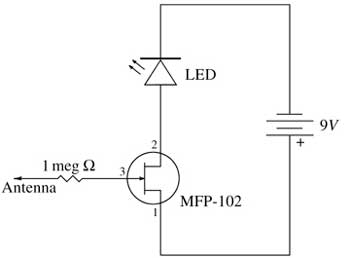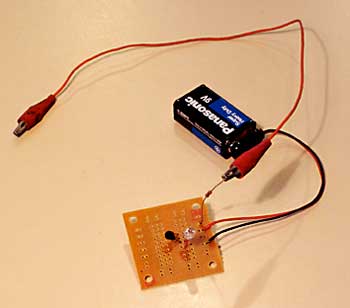
sponsor: Qi Journal
Navigation:
Portals
|
article: How is Qi Transmitted? | author: Robert Chuckrow, Ph.D | date: 2016-01-04 15:14:05
|
|
How is Ch’i (Qi) Transmitted?

Fig. 1:The circuit for a very sensitive electroscope, which can indicate the presence of minute electrostatic fields.

Fig. 2: Photo of the above electroscope.
The question naturally arises: How can ch’i be transmitted from one person to another? I have pondered this question for decades. Is this transmission electrical? That is, can minute electrical fields emanated by one person be strong enough to affect another? Actually, I have done some informal experiments by using an extremely sensitive electroscope (Figs. 1 and 2), which can detect infinitesimal electric fields. My ch’i is rather strong, and I am able to transmit it at will over a distance of several feet to others who feel it and its effects. I tried transmitting ch’i while holding my hand very close to the electroscope. No matter how hard or how many times I tried, the results were the same; the electroscope gave not the slightest indication. I also tried to use my ch’i to affect a candle flame, and this experiment was equally unsuccessful. The failure of these informal experiments certainly does not rule out an electrical component to the transmission of ch’i, but the null results prompted me to think along the following lines: Intention and the Transmission of Ch’i
As mentioned earlier, when you watch someone doing an action, your nervous system reacts sympathetically by sending the same nerve impulses for accomplishing just that action but on a lower level. What if humans are so developed that they can succeed in mirroring the nerve impulses of another person even when that person’s impulses are below the threshold of any external action? At present, there is no scientific acceptance of the idea that the intention of one person can be transmitted to and sensed by another, let alone any understanding of the mechanism by which such a transmission might occur. Nevertheless, I know from my study of Ninjutsu The most basic element of experiencing and responding to sakki can be practiced by several people as follows: All but one person (the “attacker”) stand in a circle about fifteen to twenty feet wide, with their backs to the center. The attacker holds a model knife or sword and stands in the center. He then quietly and slowly approaches one person from behind and imagines attacking with his knife. In order for the imagined attack to be realistic, the attacker must have the intention to do harm even though no harm will ensue. When the person being threatened feels the urgency to move away from the attack, he/she turns around. If the victim does not feel the attack after a reasonable amount of time, the attacker “cuts” the victim. That way the victim can then review what he/she experienced during the stages of being threatened and learn to recognize those feelings when they occur again. Often, beginners who do the above exercise fail to consciously recognize the feeling of being in danger, but their bodies “know” and react by moving visibly. It does not take long, however, for even beginners to recognize the urgent feeling of saki. The other day, I noticed a starling on my neighbor’s lawn, intently pecking for food. I focused on the bird, and it immediately stopped and looked up. Without moving, I relaxed my focus and went into my own thoughts. The bird then went back to its pecking. Again, I focused on the bird. It again looked up and then pointed one eye in my direction. Again, I relaxed my focus, and the bird then went back to its pecking. There is no question in my mind that the bird sensed my focus on it even though I had no intention of harming it. Of course, wild animals have a much greater ability than that of humans to perceive danger or respond to a connection initiated by another being. If they did not, they would not stay alive very long. Nevertheless, in my experience, humans, too, possess this ability and can vastly increase it. My experience over the years confirms that just as we can sense anger and its associated danger, we can sense intention in other areas. Thus, it may be that when one person has the intention to send healing ch’i to another, that intention may have an effect on the nervous system of the recipient, thus intensifying the recipient’s ch’i flow. How is Intention Transmitted?So far, science has not explained how a person can sense the intention of another in the absence of evident cues. The underlying phenomenon may involve the interaction of physical quantities[3] that are known but which scientists have been unable to measure.[4] Or, it may involve physical quantities that are not yet known. Perhaps the mode of transmission is not even physical, in which case, science in its present form may not have the tools with which to uncover the process involved. Endnotes:Editor's comments: The original article from which this entry was taken and abridged to fit the style and format of Qi Encyclopedia may be found at http://chuckrowtaichi.com/ChiInterpretation2.html.
[1]^ Stephen K. Hayes. The Ninja and Their Secret Fight Art. [2]^ The Essence of T'ai Chi Ch'uan: The Literary Tradition. [3]^ “A physical quantity is property of a phenomenon, body, or substance, that can be quantified by measurement.” (See http://en.wikipedia.org/wiki/Physical_quantity). [4]^ The following is an example of a phenomenon that involves the interaction of known physical quantities but which scientists are unable to measure: Theoretically, when a loaded elevator descends, the earth moves a corresponding amount in the opposite direction. Because the ratio of the mass of the earth to that of the elevator is so great, the movement of the earth is far too small to be measured. |
